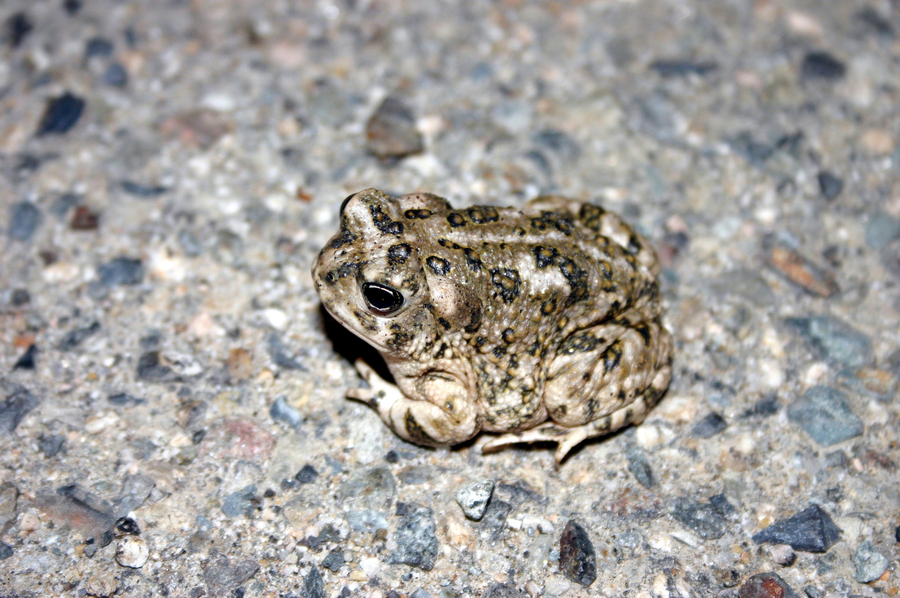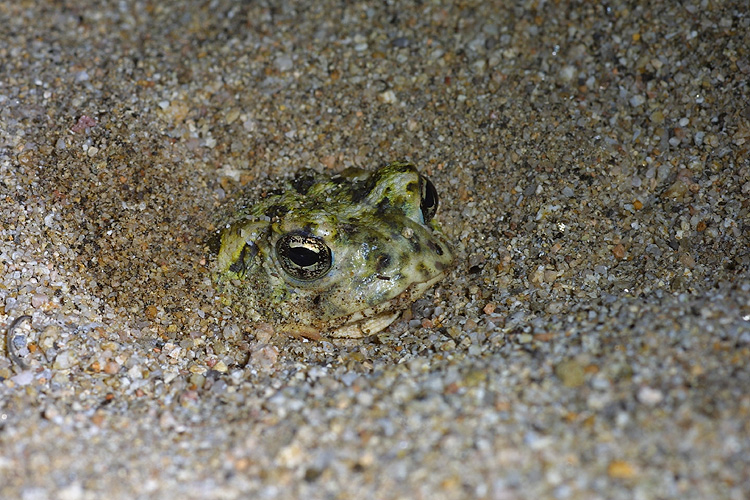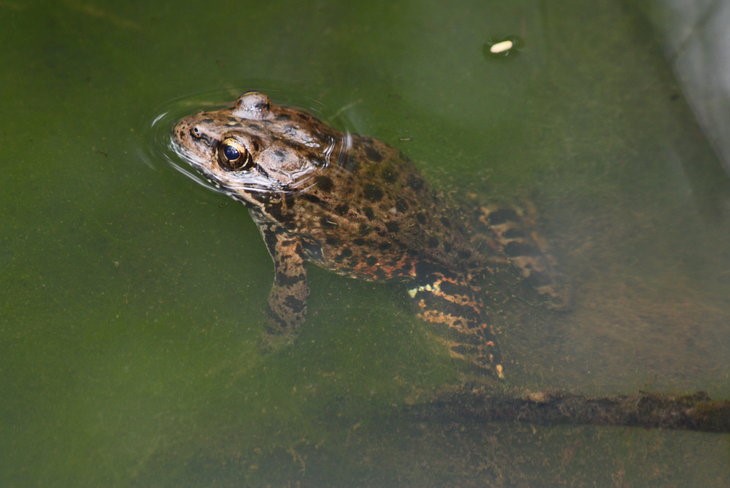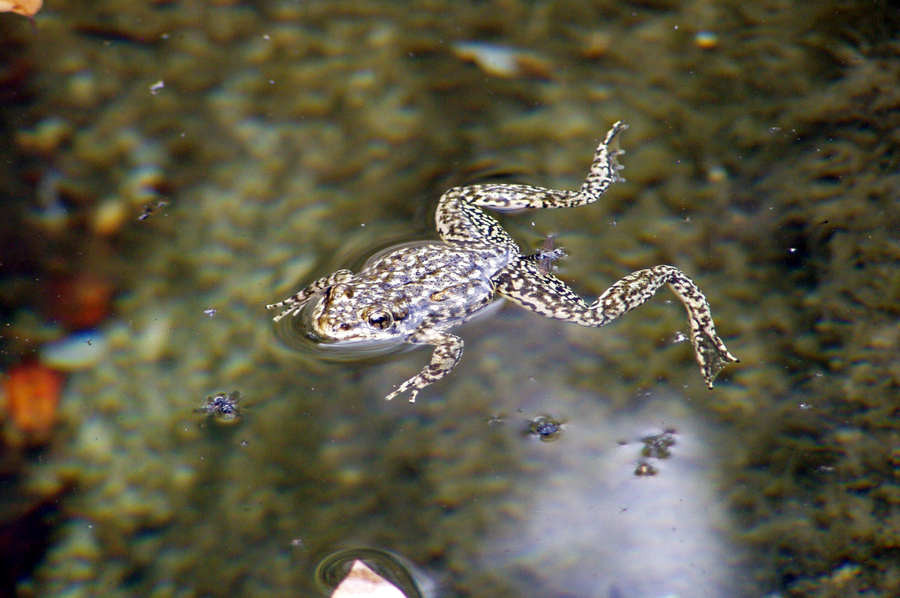To learn more about the amphibians in the map above, select a species or scroll down.
- Arroyo toad
Anaxyrus californicus - California red-legged frog
Rana draytonii - Southern mountain yellow-legged frog
Rana muscosa
What is critical habitat?
Critical habitat refers to an area that is believed to be essential to the conservation of a federally endangered or threatened species. The designated area does not necessarily include the species entire range.
Learn more
Arroyo toad, Anaxyrus californicus

STATUS
Federal status: Endangered
POPULATION TREND
= Stable
RESTORATION
Intermediate
FAMILY
Bufonidae, the true toad family
RANGE
Southern California and Northern Baja
Appearance
The Arroyo toad is a stocky, small toad (5 cm to 7.5 cm) with warty skin that is light olive green, gray, or light brown in color. It can be recognized by the light-colored, V-shaped stripe across its head and eyelids.
Habitat & Behavior
Arroyo toads are nocturnal and spends much of the day underground. The toads feed on ants and other small insects. The male toad’s call, a loud trill, can be heard from April to July.
Arroyo toad habitat is dynamic, as the toads require slow-moving sandy streams and sandy stream-side terraces to breed. These conditions can be created by periodic flooding, which modifies stream channels, redistributes channel sediments, and alters pool location and form. Outside of the breeding season, arroyo toads also occupy riparian habitats, alluvial scrub, coastal sage scrub, chaparral, grassland, and oak woodland.
Threats
The primary threats to Arroyo toads are dams and water diversion, development, introduced non-native predators, and drought. In Los Angeles, Arroyo toads are particularly susceptible to habitat damage caused by increasing recreational use of creeks, streams, and riparian areas.
Conservation
Protecting Arroyo habitat in Los Angeles, especially during the breeding season, is a high priority. Extensive surveys are also needed to identify locations in Los Angeles that need to be managed, protected, and/or restored. You can volunteer to help restore Arroyo toad stream habitat through organizations like the National Park Service, National Forest Service, and other non-profit groups.
Where can you spot it?
It is extremely difficult to see Arroyo toads, which are nocturnal and hibernate. When on the lookout for toads, always stick to designated trails, as foot traffic can cause soil compaction and degrade the toads’ habitat. The best places to see Arroyo toad habitat are riparian areas in Upper Big Tujunga Creek, Mill Creek, and Alder Creek, in Angeles National Forest.

Back to threatened amphibians list
California red-legged frog, Rana draytonii

STATUS
Federal status: Threatened
POPULATION TREND
(-) Decreasing
RESTORATION
Difficult
FAMILY
Ranidae, the most widely distributed frog family
RANGE
Coast and Sierra Nevada ranges to Northern Baja
Appearance
The California red-legged frog is the largest (4 to 14 cm) native frog in the Western United States. It varies in color from brown, gray, olive, red, or orange, often with a pattern of dark flecks or spots. The hind legs are well-developed (hence believed to be the species in Mark Twain’s book about frog jumping contests) with large webbed feet. The undersides of the adult frogs are white, usually with patches of bright red or orange on the abdomen and hind legs.
Habitat & Behavior
The California red-legged frog breeds in ponds or deep pools in slow-moving creeks. They can also breed in artificial impoundments (e.g. stock ponds). In Southern California, where ponds are seasonal in nature, thickets of willows and log jams along riparian corridors provide important breeding (November to March) and non-breeding habitat.
The red-legged frog’s call has a characteristic “uh-uh-uh-uh-uh” rhythm. Their calls serve a number of functions, such as attracting mates or warning competitors.
Threats
The main threats to the California red-legged frog are habitat destruction and degradation, recreation, non-native diseases and plants, and predators.
Conservation
An extensive recovery plan for the California red-legged frog includes protecting sites where it currently occurs and restoring habitat (ponds and riparian areas) to be protected and managed over the long term. Species distribution modeling can be used to identify potential habitat and sites for human-assisted reintroduction.
Where can you spot it?
The California red-legged frog is extremely vulnerable to human disturbance (trails, soil compaction, unintentionally introduced diseases), so it is best not to seek it out. However, you can enjoy the ponds and riparian areas that they inhabit, including in the Upper Las Virgenes Canyon Open Space Preserve in the Simi Hills in eastern Ventura County and in San Francisquito Canyon on the Angeles National Forest in Los Angeles County.
Back to threatened amphibians list
Southern mountain yellow-legged frog, Rana muscosa

STATUS
Federal status: Endangered
POPULATION TREND
= Stable
RESTORATION
Intermediate
FAMILY
Ranidae, the most widely distributed frog family
RANGE
Southern Sierra Nevadas to the Transverse Range (San Gabriel, San Jacinto, and San Bernardo Mountains)
Appearance
The body color of this small frog (4 cm to 9 cm) can vary from a mix of brown and yellow, red, or green-brown.
Habitat & Behavior
The Southern mountain yellow-legged frog occurs in mountainous riparian areas, ponds, and lakes between 300 and 2,300 meters elevation. They are diurnal, feed on aquatic insects, and are rarely found more than 1 meter away from a perennial water source. The Southern mountain yellow-legged frog hibernates in winter and breeding activity occurs from April to July.
Threats
The primary threats to the Southern mountain yellow-legged frog are pesticides, chytrid fungus, and the introduction of non-native species such as trout. Substantial declines in Southern California populations are thought to be caused primarily by non-native trout predation and habitat impacts associated with recreation.
Conservation
Recovery of the Southern mountain yellow-legged frog will require the removal of threats as well as augmentation of existing populations. Captive-breeding efforts, which can help to expand current populations or re-establish them in areas where the frogs have historically lived, has been undertaken by federal agencies. Recovery plans also call for removal of predatory non-native trout and harmful pollutants, such as chemicals used in wildfire management. There is a need for extensive surveys and monitoring, research on genetic diversity and chytrid fungus and reducing recreational impacts.
Where can you spot it?
The Southern mountain yellow-legged frog currently has been recorded in five small streams in the San Gabriel Mountains (Bear Gulch, Vincent Gulch, South Fork Big Rock Creek, Little Rock Creek, and Devil’s Canyon).
Back to threatened amphibians list
Data source:
Critical habitat from US Fish and Wildlife Service, accessed via ECOS (Environmental Conservation Online System)
References: